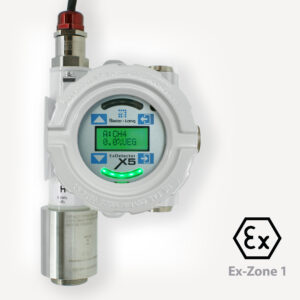VOC – Recognizing and controlling volatile organic compounds
Invisible danger, measurable safety
Volatile organic compounds (VOCs) are gaseous or easily evaporating organic substances that occur in many industrial applications and manufacturing processes. They are produced when using varnishes, solvents, adhesives, paints, cleaning agents, fuels and plastics – and are widespread in production halls, workshops and laboratories.
Despite their practical use, VOCs pose considerable health and explosion risks. Reliable VOC monitoring with suitable gas measurement technology is therefore essential for occupational safety, fire protection and legal compliance.
Health risk from VOCs – from irritation to cancer risk
Even low concentrations of VOC vapors can lead to health problems. Chronic exposure can lead to nerve damage, organ damage (liver, kidneys) and even cancer. Particularly critical: many VOCs are odorless and are only noticed at a late stage.
Typical symptoms of VOC exposure:
- Headaches, tiredness, concentration problems
- Irritation of eyes, respiratory tract and skin
- Damage to the central nervous system
- Long-term impairment of the liver and kidneys
- Suspected cancer (e.g. benzene, formaldehyde)
Occupational exposure limit values (OELs) – examples:
- Benzene: 0.5 ppm
- Toluene: 50 ppm
- Xylene: 100 ppm
Danger from long-term exposure: VOCs can accumulate unnoticed in poorly ventilated rooms – the damage to health is often gradual and irreversible.
Explosion hazard due to VOCs – flammable & highly risky
Many VOCs form flammable to explosive vapor-air mixtures with air even at low concentrations. This makes them a serious fire and explosion hazard in production and storage areas.
Explosion limits of selected VOCs:
- Toluene: 1.2 – 7.1 % by volume
- Xylene: 1.1 – 7.0 % vol.
- Acetone: 2.6 – 13 % by volume
- Ethanol: 3.3 – 19 % by volume
Ignition sources:
- Sparks
- Hot surfaces
- Static discharges
- Defective electrical appliances
ATEX-compliant gas warning systems are required by law in many industries – as are technical protective measures to avert danger.
VOC gas detectors – Precise detection for safe working environments
Our VOC Gas Detectors use state-of-the-art PID sensors (photoionization detection) or infrared technology to reliably detect even the lowest concentrations – in the ppm to ppb range.
Your advantages at a glance:
- Early detection of dangerous VOC concentrations
- Broad detection spectrum for numerous VOC types
- Real-time monitoring with audible & visual alarms
- Interfaces for ventilation and process control
- ATEX-certified solutions for potentially explosive atmospheres
Typical areas of application for VOC measurement technology:
- Chemical industry & paint production
- Plastics processing & injection molding
- Paint, adhesive & solvent production
- Print shops & packaging companies
- Pharmaceutical & cosmetic production
- Laboratories, research centers & technical rooms
- Automotive & Workshops
- Recycling & hazardous material handling
Conclusion: VOC detection is active health, environmental and explosion protection
VOCs are omnipresent – but often invisible. Our modern VOC gas detection systems enable you to monitor your working environment precisely, efficiently and in compliance with regulations. Protect people, processes and assets with timely VOC detection and avoid costly downtime, health risks and liability issues.
The following gas sensors and systems from Bieler+Lang can detect VOC vapors
We will be happy to advise you on the selection of suitable detectors and the corresponding evaluation devices for your individual application.

